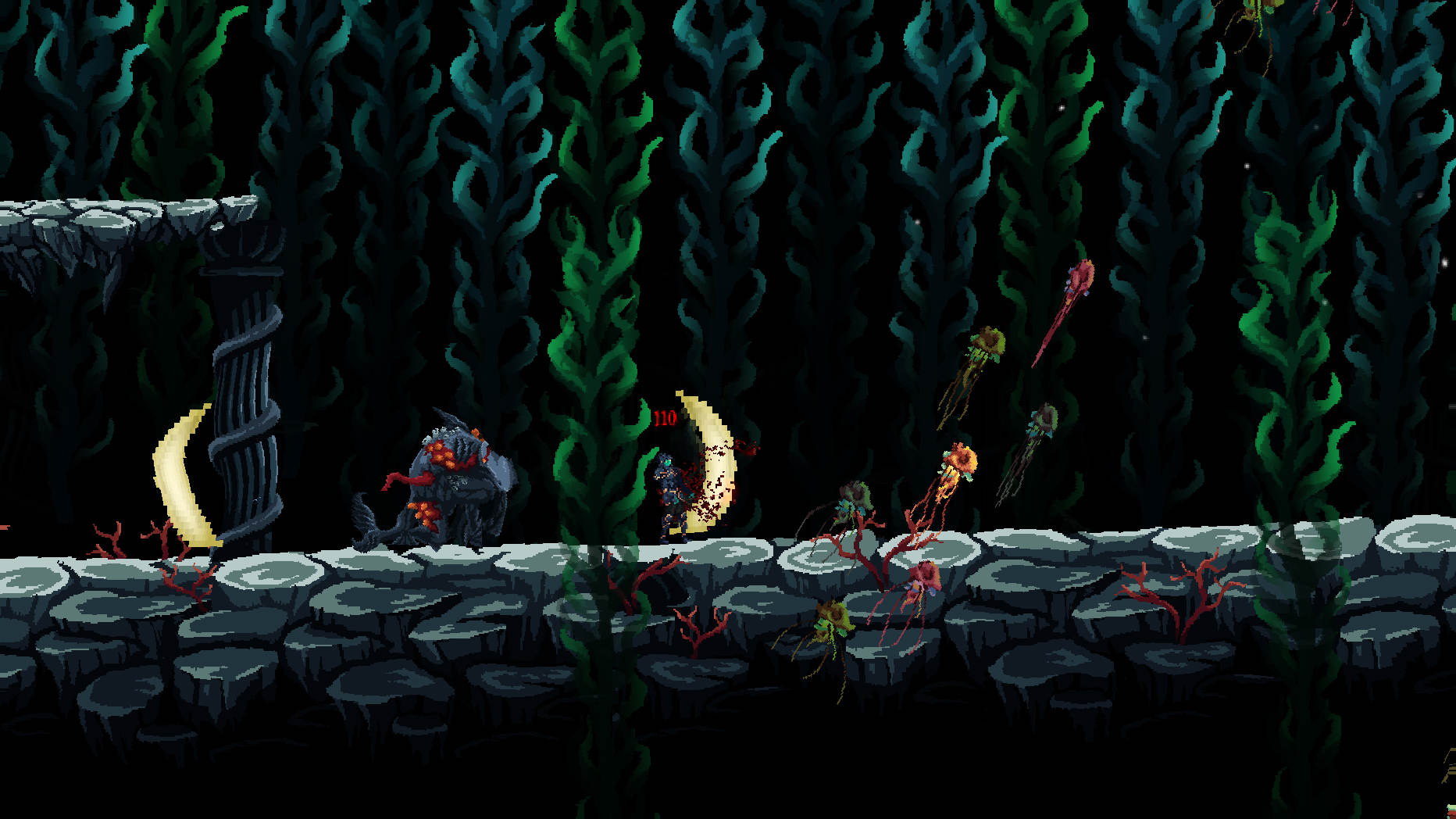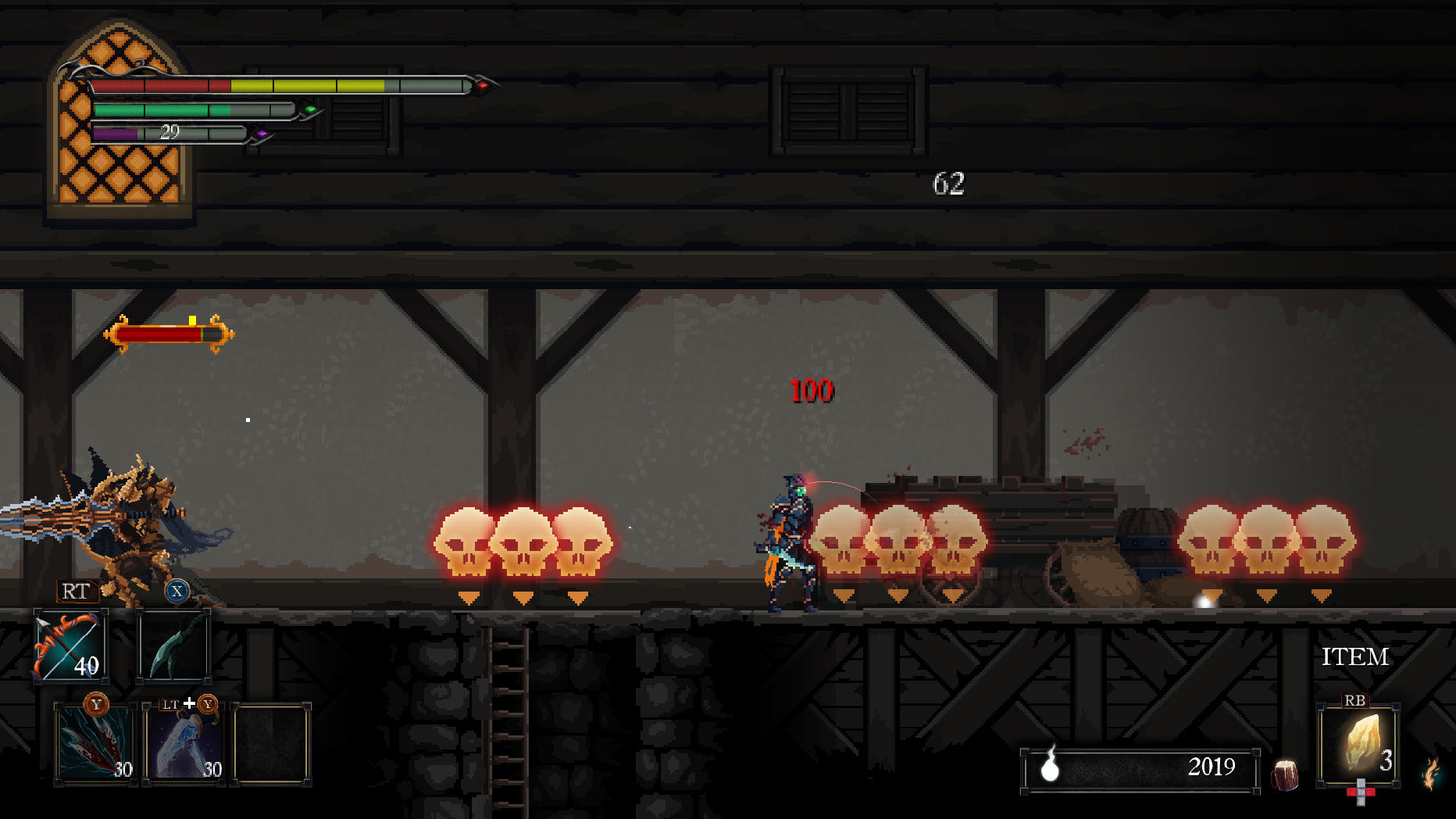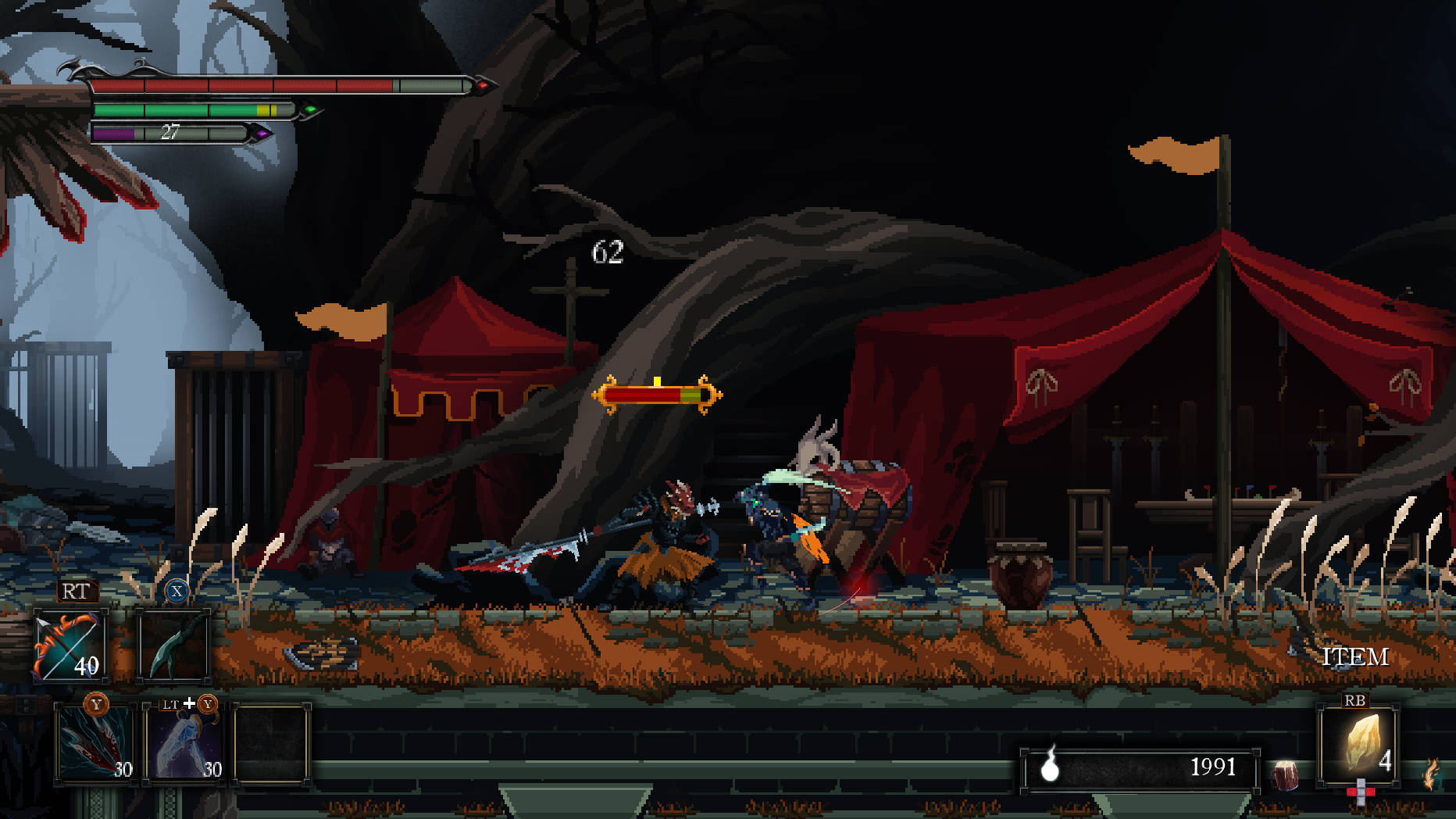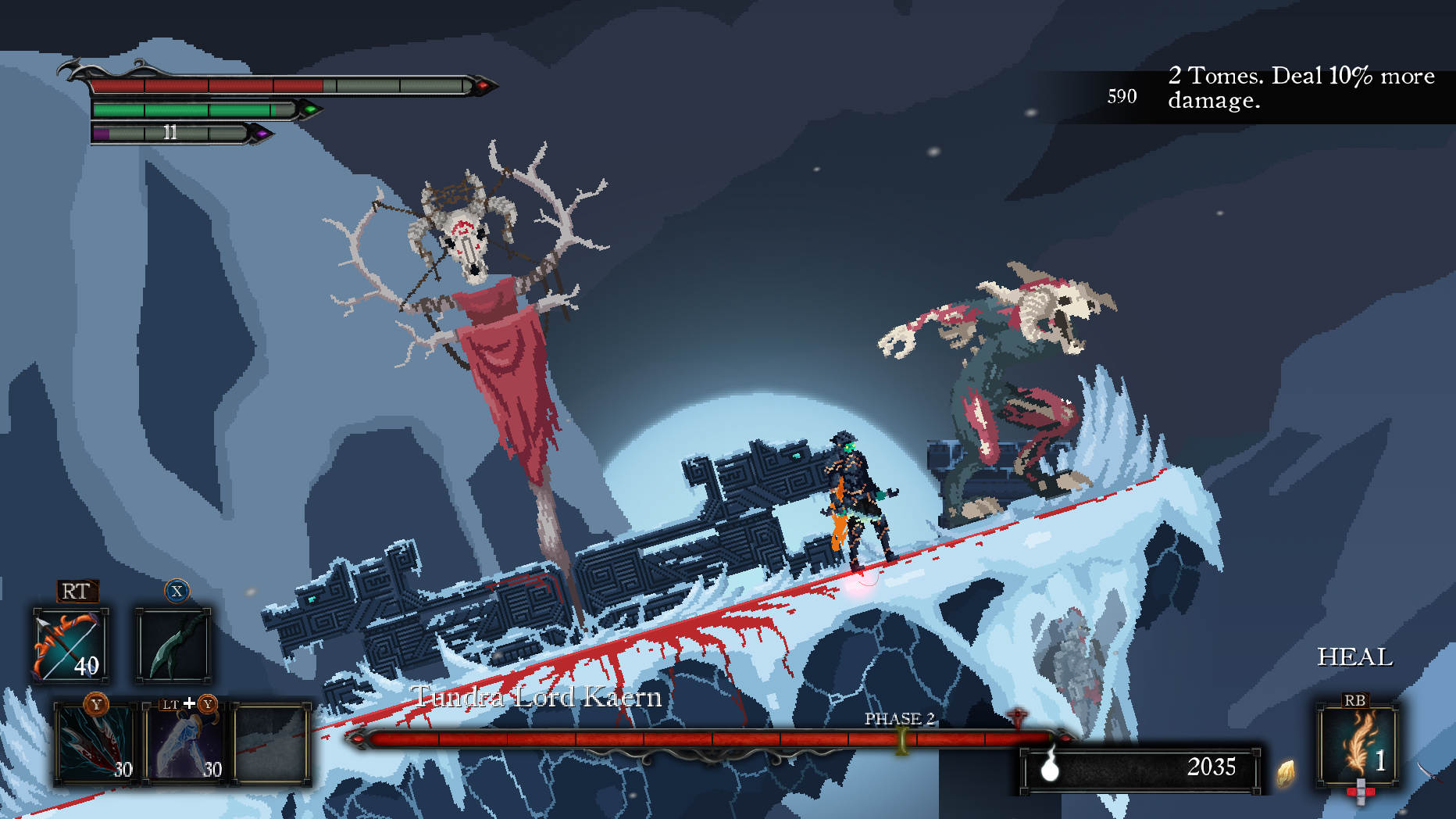Our Verdict
Ambitious ideas and a twisting story are marred by bad design choices.
PC Gamer's got your back
What is it? A Dark Souls-inspired 2D RPG with tough boss battles.
Expect to pay: $20 / £15
Developer: White Rabbit
Publisher: Adult Swim Games
Reviewed on: GTX 1050Ti, i7-7700HQ CPU, 8GB RAM
Multiplayer: None
Link: Official site
I died 29 times to one of Death’s Gambit bosses. Granted, I was still learning the ins and outs of my dagger-wielding assassin build, and the boss was backed up by a 50-foot rock monster with a blade wider than I was tall, but that tells you the type of 2D sidescroller this is. Enemies hit hard, bosses have huge health bars, and leveling up your skills to tackle the toughest fights requires a lot of patience.
Death's Gambit isn't ashamed of its Dark Souls influence, which extends far beyond the emphasis on parrying and dodge-rolling. You rest at shrines (bonfires), where you replenish healing feathers (Estus flasks) and spend accumulated shards (souls) to level up. It even jokes about the similarities at one point. But where Dark Souls is tense and endlessly rewarding, Death’s Gambit is rough and frustrating. For every original idea—of which there are many—it throws you a bizarre design choice. For every unique boss, a problem with the combat system crops up, making the the fight less fun.
The story is a good example of its inconsistency. You play as a dead warrior who makes a pact with Death, and is commanded to travel to the fortress of Caer Siorai to destroy a source of immortality that’s preventing souls from moving to the afterlife. It’s deliberately ambiguous, and your motivations gradually become clear as you progress.
I like how ambitious it is: the story is far more complex than I first thought, touching on weighty themes such as parenthood, what it means to have a family legacy, and the merits of eternal life. It’s also told in imaginative ways, pulling me out of a dungeon into a daydream on a sandy beach, or lecturing me on the size of the universe as entire planets flash past. But it never ties the threads together. Cutscenes jump forward and backwards in time, which makes it hard to follow. NPC dialogue is sometimes so obscure it only confused me. At one point, it's possible to trigger a cutscene that makes no sense if you haven’t been through a number of other areas first. Once I’d lost the plot, it was hard to pick it back up again: there’s no diary or log.

Bossed around
What structure there is comes from the 14 bosses. All of the themed areas, which are connected by two central hubs, have a boss in them, and you’ll fight them all before heading to Caer Siorai. There’s a suggested order, but you can mostly go as you please—I fought the fifth boss nearly straight away, for example. In each area you’ll travel through a network of rooms filled with enemies (which are tough in their own right), finding better equipment, new healing feathers and books granting you bonus damage in the boss fight ahead. Beat the big bad and you’ll return to the hub before striking out in a different direction.
Each boss has multiple unique abilities and uses the environment in a different way, which keeps them feeling fresh. I fought the skeletal, horned Tundra Lord Kaern on a platform that leaned left or right depending on where I stood, falling into the sky if I stood on one side for too long. Of course, the boss tried its best to trap me on one side with ice pillars. Another boss carried a sniper rifle and flitted off into the background to fire shots as I cowered behind statues, while yet another could plunge the entire arena into darkness.

Discovering boss' abilities and learning their attack patterns is the highlight of Death's Gambit. They hit hard, but they’re predictable enough never to feel unfair. Fair or not, though, a meager stamina bar can make the fights exhausting. Attacking, jumping or dodging drains it, and in three rolls and a couple of swings I’d fully depleted it. I must have seen the “not enough stamina” message a thousand times. Just when I was building momentum, I had to stop for a break.
Leveling up stamina is thus necessary, which meant I had to sacrifice potential points in my damage stats. The combat is meant to be slow and deliberate, but that cautious style isn't much fun if you can't deal a lot of damage, too. There were times where I could consistently dodge bosses, but just didn’t have the DPS to beat them. It gets better later in the game, where shards are more plentiful, but the first half was a slog.
Dead weight
At times, I could see little other than my character outline for minutes on end.
If you’re not fighting, you’re likely jumping platform to platform, which feels too punishing. I enjoyed exploring every area, and there were enough secrets on faraway ledges and hidden dropdowns to tempt me into daring leaps, but the character has zero momentum in the air, so if I let go of the control stick mid-jump they’d stop dead and fall to the ground like a rock (there’s no fall damage, but still).
It’s the same story—good idea ruined by a bad design choice—with the world, which is crammed with colour and detail. I moved from a snowy tundra to a sci-fi lair with mechanical platforms and flashing lights, and then onto an underground torture chamber with blades swinging from the ceilings. The variety can sometimes feel jarring, and Death's Gambit doesn’t bother trying to tie the different themes together, but I like that the developers have just packed in as many ideas as they could. It means I was never sure what was coming next, which encouraged me to push on.
There are two problems. First, some areas are simply too dark to enjoy, including the sci-fi base. At times, I could see little other than my character outline for minutes on end. In a game that encourages exploration, and looks as good as it does, it’s frustrating. Even more frustrating, though, is that I couldn’t enjoy the art in full-screen. Trying to play at a proper resolution changed the actual speed of the game to a crawl. I’m not alone, and there are a number of other issues reported by players with different monitors and specs, including laptops and 4K displays. The developers are working on fixes, and I could get around it by playing in windowed mode, but it’s hardly ideal.

Element of surprise
If you can ride out the bumpy bits, Death's Gambit is a stream of strange and creative ideas. When you die, your corpse is dumped in a room, the bodies gradually stacking up. Die enough times and you can clamber up the pile, jump onto a ledge, and pick up a handful of power-ups. In one section, I was asked to pick a polarity, positive or negative, before wading through a few rooms of enemies and a boss, and I dealt more damage to enemies with the opposite polarity. In another area, I was given a rapid-fire energy gun to play with until I was bored, just because.
Like the themes of each area, these ideas feel unrelated: it’s as if the developers just kept coming up with cool things to do and dropping them at random places. But as with the world design, I’m fine with that because it's fun trying new things, never being stuck for long with one idea. Even the ideas that don’t fully land—the energy gun is like every other energy gun I’ve used—made me want to explore every passage to see what lay ahead.

And if you beat Death's Gambit, you can get another 20 hours of enjoyment from repeat playthroughs. At the start of the game you pick one of seven classes, and they're all nicely distinct. My assassin gained soul energy—used for special abilities—every time they dodged. The Blood Knight can gain back a portion of any health they lose if they deal damage immediately after, while the Acolyte of Death can restore broken shrines, essentially giving you extra save points.
Pleasantly, items are not restricted by class, so I could’ve played a wizard wielding a greatsword, or an assassin with a spellbook. I constantly came across items that made me want to go back and make a new build. A spell blade made me wish I had more Intelligence, while a fancy glow-in-the-dark shield made me dump all my points in Strength for the next five levels so I could carry it.
That freedom, and the constant sense that I’d be surprised when I turned the next corner, somewhat smoothed over the frustrations of Death’s Gambit, but it’d be a stretch to say I enjoyed it as a whole. Figuring out the best strategy for each boss fight is satisfying, but actually beating them isn’t fun enough to justify the pain of battling the stingy stamina system. Throwing myself at the same boss 29 times in a row just wasn’t quite worth the hassle.
Ambitious ideas and a twisting story are marred by bad design choices.
Samuel Horti is a long-time freelance writer for PC Gamer based in the UK, who loves RPGs and making long lists of games he'll never have time to play.



